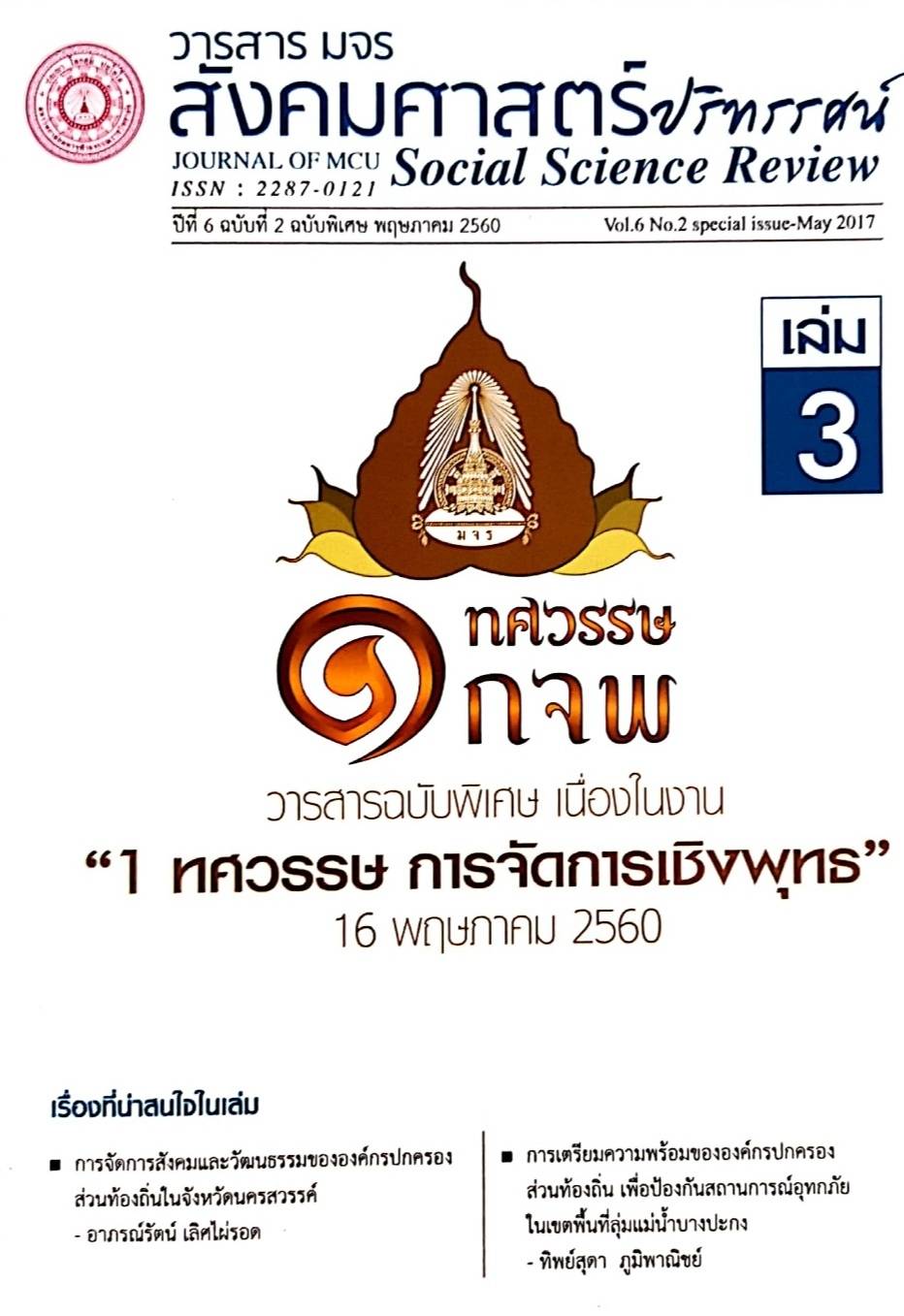อนาคตภาพของการจัดการศึกษาตลอดชีวิตเพื่อพัฒนาคุณภาพชีวิตของเยาวชนในศูนย์เยาวชน เขตพัฒนาพื้นที่พิเศษเฉพาะกิจจังหวัดชายแดนภาคใต้
คำสำคัญ:
เขตพัฒนาพื้นที่พิเศษเฉพาะกิจจังหวัดชายแดนภาคใต้; การศึกษาตลอดชีวิต; เยาวชนบทคัดย่อ
การวิจัยครั้งนี้เป็นการศึกษาเพื่อสำรวจสภาพปัญหาและความต้องการของการจัดการศึกษาตลอดชีวิตและเพื่อนำเสนอภาพอนาคตที่เป็นไปได้ในการจัดการศึกษาตลอดชีวิตในการพัฒนาคุณภาพชีวิตสำหรับเยาวชนในศูนย์เยาวชนเขตพัฒนาพื้นที่พิเศษเฉพาะกิจจังหวัดชายแดนภาคใต้ในทศวรรษหน้า (พ.ศ. 2556-2565) การเก็บข้อมูลโดยการสัมภาษณ์เชิงลึก (In-depth Interview) เพื่อสำรวจสภาพปัญหาและความต้องการของการจัดการศึกษาตลอดชีวิตของเยาวชนในเขตพัฒนาพื้นที่พิเศษเฉพาะกิจจังหวัดชายแดนภาคใต้ ใช้เทคนิคการวิจัยแบบ EDFR (Ethnographic Delphi Futures Research) และทำการวิเคราะห์ผลกระทบภาคตัดขวาง (Cross-Impact Analysis) และวางแผนภาพอนาคต (Scenario Planning) เพื่อแสวงหาแนวคิดหรือบทบาทสำหรับหน่วยงานหรือองค์กรที่เกี่ยวข้องซึ่งจะนำไปสู่การกำหนดนโยบาย ยุทธศาสตร์ แนวทางการจัดการศึกษา การส่งเสริม สนับสนุน การเตรียมตัวป้องกันและการเตรียมการต่าง ๆ สำหรับการจัดการศึกษาตลอดชีวิตเพื่อพัฒนาคุณภาพชีวิตของเยาวชนในศูนย์เยาวชนเขตพัฒนาพื้นที่พิเศษเฉพาะกิจจังหวัดชายแดนภาคใต้ในทศวรรษหน้า (พ.ศ. 2556-2565) ที่ชัดเจนต่อไป ผลการวิจัยพบว่า
อนาคตภาพที่พึงประสงค์ (Optimistic-Realistic Scenario) จะต้องมีการกำหนดหลักสูตร/ เนื้อหาที่สอดคล้องกับวิถีชีวิตของคนในพื้นที่และคำนึงถึงความต้องการของชุมชนเป็นหลัก ไม่ควรยึดนโยบายมาจากต่างประเทศให้เน้นการเรียนการสอนวิชาประวัติศาสตร์และหน้าที่ความเป็นพลเมือง รวมทั้งเร่งเพิ่มทักษะ/อาชีพในศตวรรษที่ 21 และทักษะการเรียน การสอนด้านภาษาอังกฤษ
อนาคตภาพที่ไม่พึงประสงค์ (Pessimistic-Realistic Scenario) ต้องไม่พิจารณาเรื่องความมั่นคงของมนุษย์มากกว่าความมั่นคงของรัฐในการกำหนดนโยบายการศึกษาในเขตพื้นที่พิเศษเฉพาะกิจจังหวัดชายแดนภาคใต้
อนาคตภาพที่น่าจะเป็นไปได้มากที่สุด (Most-Probable Scenario) เกี่ยวกับการจัดการศึกษาตลอดชีวิตเพื่อพัฒนาคุณภาพชีวิตของเยาวชนในศูนย์เยาวชนเขตพัฒนาพื้นที่พิเศษเฉพาะกิจจังหวัดชายแดนภาคใต้แบ่งเป็น 5 ด้าน ดังนี้ 1) ด้านหลักสูตร/เนื้อหา : เปิดโอกาสให้ประชาชนในพื้นที่ทุกฝ่ายเข้าไปมีส่วนร่วมให้มากที่สุด 2) ด้านวิธีสอน/กิจกรรม : สนับสนุนให้ปฏิบัติศาสนกิจตามศาสนาของผู้เรียนอย่างเสมอภาคและเท่าเทียมโดยมีการหลอมรวม บูรณาการศาสนา วิชาสามัญ สอดแทรกวิชาชีพเพื่อให้เยาวชนสามารถนำความรู้ไปประกอบอาชีพ 3) ด้านผู้สอน/วิทยากร : ครูจะต้องรักและเข้าใจท้องถิ่น มีจิตวิญญาณของความเป็นครูอย่างแท้จริงจะต้องคำนึงถึงสัจธรรม (Truth) ความยุติธรรม (Justice) ความรัก (Love) และเสรีภาพ (Freedom) 4) ด้านบรรยากาศ/สภาพแวดล้อม : สนับสนุนให้เอกชน พ่อแม่ ผู้ปกครอง องค์กรชุมชน สถาบันศาสนา สถานประกอบการและสถาบันทางสังคมอื่นๆ เข้ามามีส่วนร่วมในการจัดการศึกษาโดยส่งเสริมให้สถานศึกษาระดมทรัพยากรบุคคล ภูมิปัญญาท้องถิ่น ปราชญ์ชาวบ้าน และผู้ทรงคุณวุฒิในชุมชน/ท้องถิ่นเพื่อเป็นผู้สอนและพัฒนาการเรียนรู้5) ด้านการวัดและการประเมินผล : มีวิธีการประเมินผลอย่างหลากหลาย ควรเน้นการปฏิบัติมากกว่าทฤษฎี ปฏิรูปการทดสอบมาตรฐานในระดับประเทศเป็นการทดสอบเพื่อวัดความรู้ความเข้าใจและทักษะ (Literacy - Based Test) ซึ่งสามารถประยุกต์เนื้อหาเข้ากับโจทย์จริงในชีวิตประจำวันได้และนำผลการทดสอบมาตรฐานระดับประเทศแบบใหม่ไปสร้างความรับผิดชอบในระบบการศึกษา เช่น การประเมินผลงานของครู การประเมินสถานศึกษาเพื่อพัฒนาคุณภาพ
เอกสารอ้างอิง
The Adult and Continuing Education of Korea. (2007).Finding Places for Asian Lifelong Educational in Globalizing World. International Conference 2007. Seoul, Korea.
UNESCO. (1970). An Introduction to LifelongEducation. Paris: UNESCO.
World Bank. (2002) Lifelong Learning in the Global for Developing Countries. OCED: The World Bank Education.
กระทรวงการพัฒนาสังคมและความมั่นคงของมนุษย์. (2555). การศึกษาและพัฒนามาตรฐานและตัวชี้วัดความมั่นคงของมนุษย์. กรุงเทพมหานคร : มปท.
คณะกรรมการส่งเสริมการพัฒนาเด็กและเยาวชนแห่งชาติ. (2554).แผนพัฒนาเด็กและเยาวชนแห่งชาติ พ.ศ.2555 – 2559.กรุงเทพมหานคร:โรงพิมพ์ชุมนุมสหกรณ์การเกษตรแห่งประเทศไทย.
วรรณี แกมเกตุ.(2551). วิธีวิทยาการวิจัยทางพฤติกรรมศาสตร์. (พิมพ์ครั้งที่ 2). กรุงเทพมหานคร : โรงพิมพ์แห่งจุฬาลงกรณ์มหาวิทยาลัย
สยามรัฐ. (21 สิงหาคม 2557) วอน รบ. เร่งผลักดัน พรบ.การศึกษาตลอดชีวิต เอื้อเด็กนอกระบบ – รับสังคมคนสูงวัย. กรุงเทพมหานคร.
สำนักงานคณะกรรมการพัฒนาการเศรษฐกิจและสังคมแห่งชาติ. (2558).แผนพัฒนาเศรษฐกิจและสังคมแห่งชาติ ฉบับที่สิบเอ็ด พ.ศ.2554 – 2559. [ออนไลน์]
สำนักงานเลขาธิการสภาการศึกษา. (2554). นโยบายและยุทธศาสตร์การขับเคลื่อนการ ปฎิรูปการศึกษาด้านการเพิ่มโอกาสทางการศึกษาและการเรียนรู้.กรุงเทพมหานคร : สำนักนโยบายด้านการจัดการเรียนรู้ตลอดชีวิตและโอกาสทางการศึกษา สำนักงานเลขาธิการสภาการศึกษา.
สำนักงานเลขาธิการสภาการศึกษา. (2552). แผนการศึกษาแห่งชาติ ฉบับปรับปรุง(พ.ศ.2552 – 2559). กรุงเทพมหานคร : พริกหวานกราฟฟิค.
สำนักวิชาการและมาตรฐานการศึกษา กระทรวงศึกษาธิการ. (2551).แนวทางการจัดกิจกรรมพัฒนาผู้เรียน ตามหลักสูตรแกนกลางการศึกษาขั้นพื้นฐาน พุทธศักราช 2551. กรุงเทพมหานคร : พิมพ์ครั้งที่ 2. โรงพิมพ์ชุมนุมสหกรณ์การเกษตรแห่งประเทศไทย จำกัด.
สุวัฒน์ มหัตนิรันดร์กุล. (2540). เปรียบเทียบแบบวัดคุณภาพชีวิตขององค์การอนามัยโลกชุด 300 ตัวชี้วัดและ 26 ตัวชี้วัด.กรุงเทพมหานคร.
เสริมศักดิ์ วิศาลาภรณ์ และคณะ. (2550). รายงานการวิจัย เรื่อง สภาพการจัดการศึกษาในจังหวัดชายแดนภาคใต้. กรุงเทพมหานคร : วีทีซี คอมิวนิเคชั่น.
ดาวน์โหลด
เผยแพร่แล้ว
รูปแบบการอ้างอิง
ฉบับ
ประเภทบทความ
สัญญาอนุญาต
ลิขสิทธิ์ (c) 2020 วารสาร มจร สังคมศาสตร์ปริทรรศน์

อนุญาตภายใต้เงื่อนไข Creative Commons Attribution-NonCommercial-NoDerivatives 4.0 International License.
เพื่อให้เป็นไปตามกฎหมายลิขสิทธิ์ ผู้นิพนธ์ทุกท่านต้องลงลายมือชื่อในแบบฟอร์มใบมอบลิขสิทธิ์บทความให้แก่วารสารฯ พร้อมกับบทความต้นฉบับที่ได้แก้ไขครั้งสุดท้าย นอกจากนี้ ผู้นิพนธ์ทุกท่านต้องยืนยันว่าบทความต้นฉบับที่ส่งมาตีพิมพ์นั้น ได้ส่งมาตีพิมพ์เฉพาะในวารสาร มจร สังคมศาสตร์ปริทรรศน์ เพียงแห่งเดียวเท่านั้น หากมีการใช้ภาพหรือตารางหรือเนื้อหาอื่นๆ ของผู้นิพนธ์อื่นที่ปรากฏในสิ่งตีพิมพ์อื่นมาแล้ว ผู้นิพนธ์ต้องขออนุญาตเจ้าของลิขสิทธิ์ก่อน พร้อมทั้งแสดงหนังสือที่ได้รับการยินยอมต่อบรรณาธิการ ก่อนที่บทความจะได้รับการตีพิมพ์ หากไม่เป็นไปตามข้อกำหนดเบื้องต้น ทางวารสารจะถอดบทความของท่านออกโดยไม่มีข้อยกเว้นใดๆ ทั้งสิ้น





